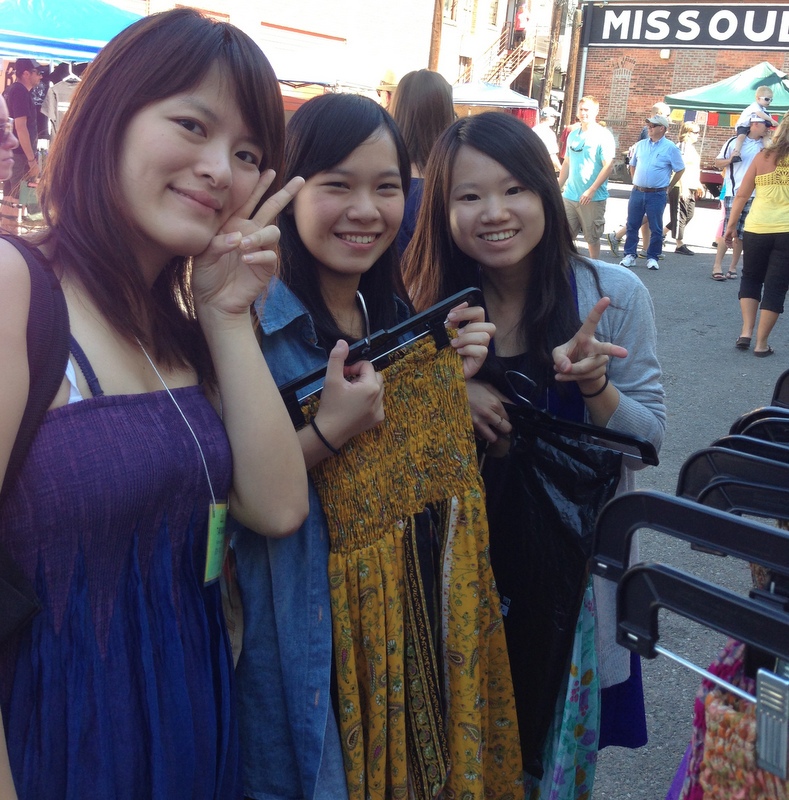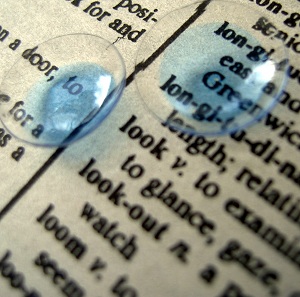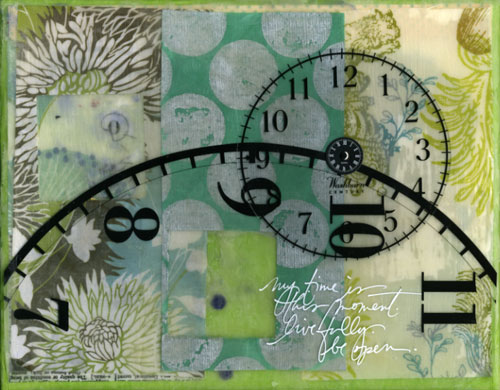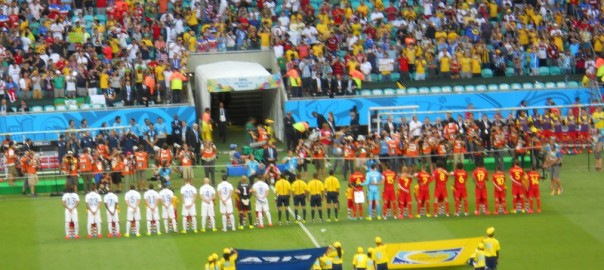Brazilians love their futbol. O jogo bonito, they call it. The beautiful game. I had the good fortune of witnessing this love firsthand when, topping my husband’s bucket list, World Cup 2014 drew our family to Salvador, Brazil.
Truth be told, though I was looking forward to seeing some games, I was more excited about spending time with our sons, Eric and Colin. Living five hundred miles apart, our opportunities to get together are limited. Anticipating more than three weeks of family bonding had me over the moon.
What I hadn’t envisioned—something zealous soccer fans will have a hard time understanding—is just how electrifying it would be. To be. In Brazil. For the World Cup.
I’m no stranger to soccer. Rich and I began playing in our mid-twenties and, years later, I became a soccer mom. That status segued the summer of 2010 when our family played together on a co-rec team. Playing short one sweltering July evening, I was assigned to midfield. I still smile at the memory of Colin hollering, “MOM! GO TO THE BALL!” O jogo bonito it was not.
Fast-forward to June, 2014. In the preparatory reading I did on the plane, I learned new—to me—soccer terms. Matches. Penalties. Pitch. Set plays. I read about the World Cup groups, teams, and star players. I learned that, after sixty-four years, Brazil’s devastating 1950 World Cup loss to Uruguay—coined el Maracanaço, the Maracanã blow—remained an open wound. A 2014 Brazil World Cup victory at Estádio do Maracanã could erase the lingering sorrow.
As we queued with hundreds of others to watch the opening match at Salvador’s FIFA Fan Fest, the excitement was palpable. Brahma flowed; drum beats, cheers, and vuvuzelas created a cacophony of noise; Brasil’s yellow and green ruled the night; and the home team won. It was magical.
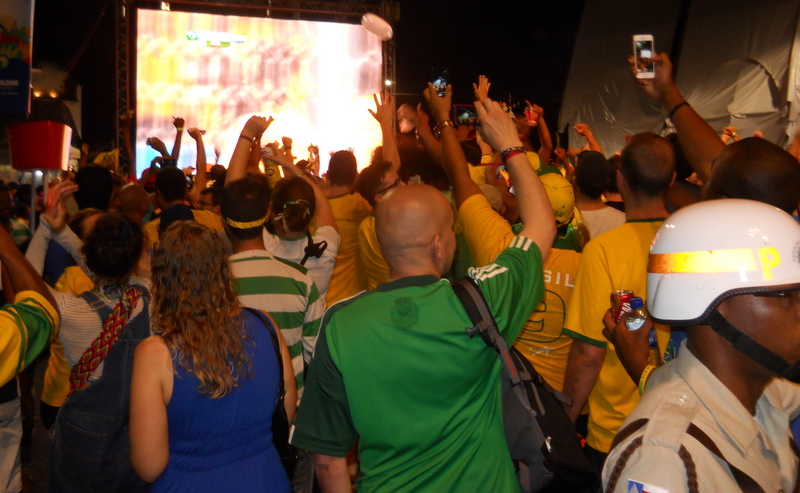
Throughout the ensuing days, the air sizzled as futbol reigned supreme. Soccer jerseys, flags and team colors led to conversations among strangers—filled with either pre-match anticipation and speculation, or post-match jubilation or angst. Whether watching a match at our pousada, in a restaurant, at the Fan Fest, or live at Arena Fonte Nova, it was a treat to gather with others—including more than fifty thousand in the Arena—and be a part of the ebb and flow of groans and cheers, high fives and stadium waves.
Before the France vs Switzerland match, I crafted a rudimentary sign, hoping to connect with our French student, Jordane, across the airwaves. Approaching the stadium, I was on a mission to score face paint to increase my odds. I spotted a young woman painting flowers on her cheeks—mirror in one hand, brush in the other. A young man, whose entire face was painted blue, white and red, supervised her handiwork. They were Brazilians, I learned, supporters of Esporte Clube Bahia, the local team which shares the French colors. As the woman interrupted her artistry to finger paint two flags for me, I told them our French friend was hoping to see us on TV. Her friend laughed and, carefully sandwiching his face between his hands, said, “I want to be on TV, too!”
I hope he was successful.
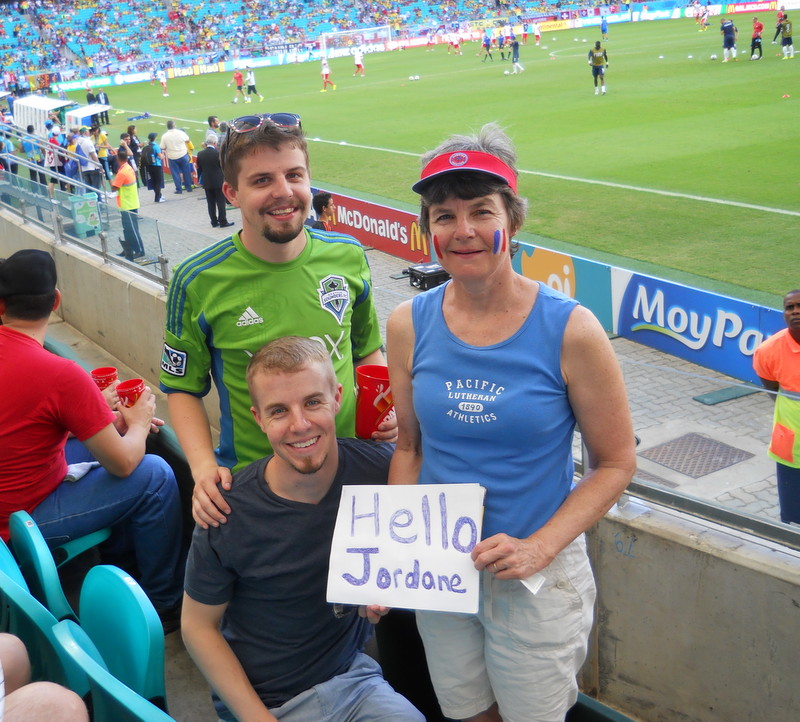
Television cameras did not swing our way during the game. Outside the stadium, though, Colin and I hurried to a random camera to wave my sign and cheer France’s victory. Perhaps someone—somewhere—saw us, but we did not receive reports of a sighting from anyone we knew.
Added sweetness to our World Cup adventures included being joined by twenty-four other Missoulians three days before USA played Belgium in the Round of 16. In Salvador. On game day, Rich, Colin and several of the Missoula crew bused to the Pelourinho, the Historic Centre, where they found a dance-club-turned-game-watching-venue to watch Argentina beat Switzerland.
Joined by a group of boisterous Belgians, there was playful bantering regarding the anticipated outcome of the USA vs Belgium match. Many of the Missoula fans shared a confidence that the US would triumph.
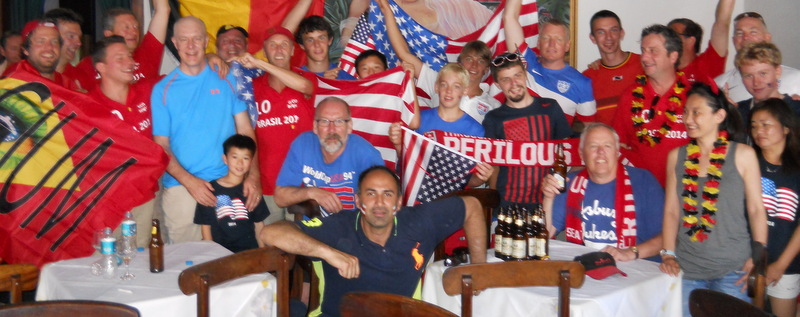
Dressed for victory, a faction of Missoulians was interviewed by Norwegian and Ukrainian television stations before the match, and by NBC and BeIN Sports after. ESPN captured them on camera, too; later replaying their enthusiasm on Sports Center.
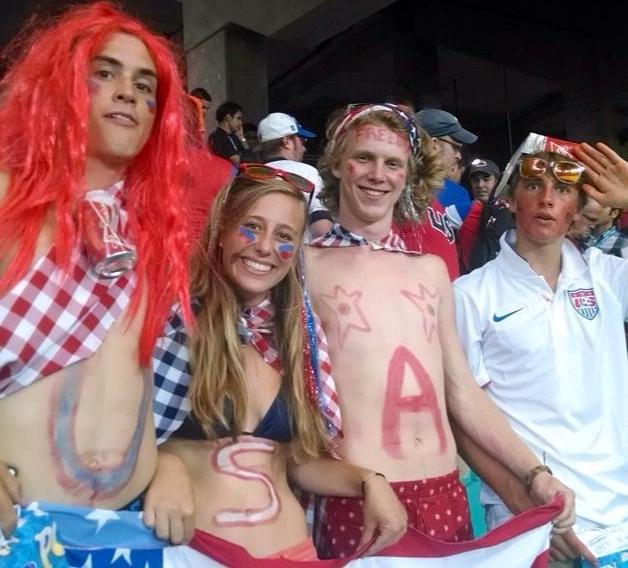
But a victory was not to be had.
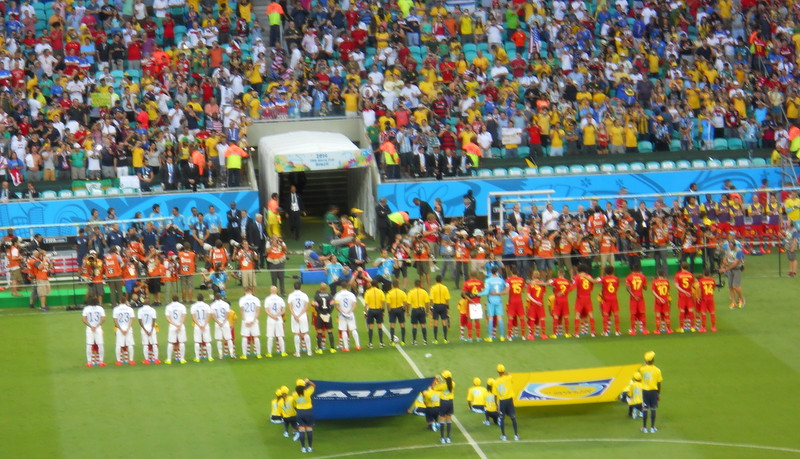
Still, it was thrilling to see the US play. Watching them, and witnessing Tim Howard’s record-breaking sixteen saves in a World Cup match, was priceless. They played a hard-fought battle and, though they lost, USA deserves a thumbs up for making it to the Round of 16.
The Belgium team deserves a thumbs up as well. Their fans’ cheers permeated the stadium at the end of extra-time as they reveled in their team’s success. Not wanting to watch their post-game celebration, we scooted to the exit.
As we made our way through the Pelourinho, a Brazilian woman stopped Eric and me. “She wants to talk to you,” she said, gesturing to the school-aged girl beside her.
“I just want to say,” the girl said in a quiet voice, “that I’m mad that we lost, but I think we’ll win the next World Cup.” She lived in California, she told us, and the woman, her aunt, lived in Salvador. Her mom had watched the game with them, too, “but she’s over there.” She motioned across the square before adding, “She’s mad.” We ended our conversation with smiles and a shared hope for a 2018 USA victory.
Two blocks later, we were stopped again in the Praça da Sé. A reporter asked Eric if she could interview him for TeleSUR, a Venezuelan news station. Serendipitous, since Eric had worked in Venezuela a few years ago. The reporter asked him to add my USA scarf to his nondescript blue shirt, then the camera rolled.
Throughout our stay, I watched people from all around the world come together, and I witnessed how quickly a smile or a thumbs up transcended language barriers. A special thumbs up for Joseph Santini, proprietor extraordinaire, and his entire staff of the Pousada Manga Rosa, Portal do Mar Restaurante, and Dolce Vita Pizzaria. They love their futbol. And I feel their pain.
